This is the website of Abulsme Noibatno Itramne (also known as Sam Minter).
Posts here are rare these days. For current stuff, follow me on Mastodon
|
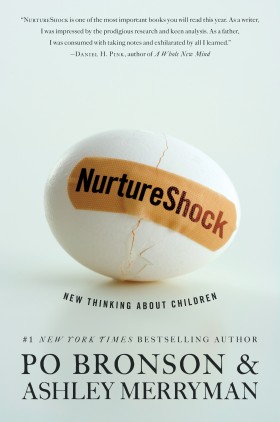 Author: Po Bronson and Ashley Merryman Author: Po Bronson and Ashley Merryman
Original Publication: 2009 Sep 3
Started: 2010 Dec 22
Finished: 2011 Jan 3
Format: Hardcover
336 pages / 13 days
25.8 pages/day
I am now so far behind in these, it is a miracle I remember the books at all. It has been over six months since I finished this book. Uh… make that 7 months… Oops. Oh well, let me give it a try anyway. This was the second “parenting” kind of book I read in a relatively short period of time. But I swear it was complete coincidence, it is what came up next.
Anyway, this one just reviews a bunch of different areas where research into child development has shown counterintuitive results and where simple things perhaps have a much greater effect than one might otherwise expect. Things like how praising a child for BEING smart is actually counterproductive, while praising them for something they DID that was smart helps quite a bit. Which makes sense when you think about it of course, but they show a lot of the backup research, lay it out, etc. I think that one was the first chapter.
That is just one of many examples. They key to each of these is that they take relevant research, walk through the situations, the results of the research, etc and then apply it. Nothing is just “this is the right way to do this because I think it is”. Everything is backed up and nothing is actually that absolute. And they are all interesting bits that you may or may not have thought of otherwise.
Anyway, I found this fun and interesting. Now, several months later do I actually remember much of it? Nah. In fact I had to go online to remind myself of the one example I used above. But still, it was a good read. And it does seem like it had some good points that I could be applying to both Alex and Amy right now.
Uh… if only I could remember them.
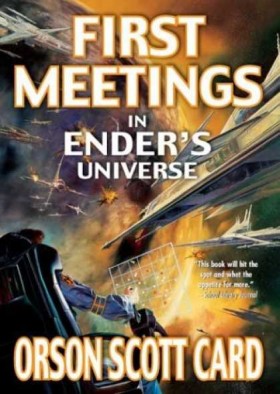 Author: Orson Scott Card Author: Orson Scott Card
Original Publication: 2003
Started: 2010 Dec 17
Finished : 2010 Dec 22
Format: Paperback
2676 locations / 6 days
446 locations / day
Up to #8 in the Ender Series. This one isn’t a novel though, but a compilation of four short stories. One is about Ender’s father as a child. One is the story of Ender’s parents meeting. Then there is the original Ender’s Game short story that Ender’s Game novel was an expansion of. And finally the story of how Ender first met Jane the sentient computer program/network.
This made it very different than reading any of the actual novels in the series. I enjoyed the two backstory ones about ender’s parents. You understand a little bit better where Ender came from, and it fleshes them out a bit. Similarly, I liked the Jane origin story, although it seemed slightly gimmicky.
The oddest one though was the Ender’s Game short story. Not that it was a bad short story, it was a good one, and of course prompted this whole series. But having it included this way was a bit jarring, since I’m reading the series in sequence, but this essentially retells the first story, but in a bit different way. It was interesting to see the differences between the short story version and the novel length version, but still, a little odd to read this as part of the overall sequence of the series.
I do like the novels better. But this was an interesting addition to the Ender Universe.
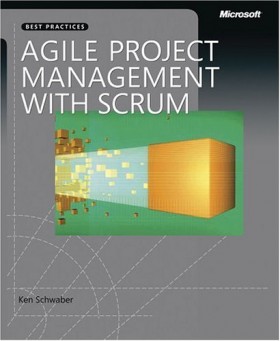 Author: Ken Schwaber Author: Ken Schwaber
Original Publication: 2004 Mar 10
Started: 2010 Nov 30
Finished : 2010 Dec 17
Format: Paperback
163 pages / 18 days
9.06 pages / day
So, having been involved with Scrum like project management methods for a few years, I finally read one of the books about it. This one specifically was about how to adapt Scrum to various sorts of situations, generally where Scrum was not used in the past.
I’d expected this would all just be “well duh” sorts of things since I’ve been in such a scrum centric environment for the last few years, but the reality is that what we’ve used where I’ve been, either directly in my group, or in others I’ve dealt with, has generally been highly adapted scrum, with many changes from “pure” scrum. Now, changing things to adapt to local needs is actually part of what Scrum anticipates, but actually reading something that had a more “pure” focus was interesting. I had many “Ah, so THAT is how that should be done” sort of moments. Well, “should” is a strong word. Maybe “could” would be better. The ways I’ve done it or seen it done are not necessarily worse, just different.
Anyway, interesting to actually read a book like this. Probably would have been more useful for me two or three or four years ago, but hey, that’s the way things go.
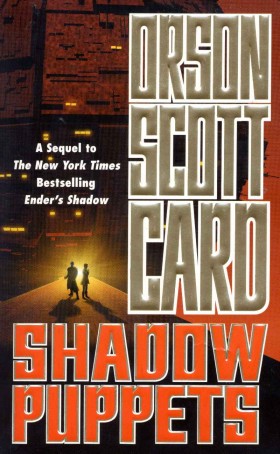 Author: Orson Scott Card Author: Orson Scott Card
Original Publication: 2002
Started: 2010 Nov 23
Finished : 2010 Nov 30
Format: Kindle
5563 locations / 8 days
695 locations / day
So, we’re now up to the 7th book in the Ender series. Shadow Puppets picks up soon after the last one ended up. But the main source of drama switches again, and the book seems to start moving back to the more philosophical sort of orientation as books 2-4 as compared to the more “things happening” sort of orientation of Books 1, 5 and 6. Which is OK I guess, but in this case a bunch of it seems to be pushing the whole “the purpose of life is to produce children” sort of agenda. Which actually started to get annoying.
The main plot point is that Bean, who is a genetically enhanced individual who gains great intelligence at the expense of abnormal growth patterns and an early death, initially intended not to have any children at all. But he is convinced otherwise. But they decide to create a number of embryos, test them for his condition, and only actually bring the ones without the condition to term. But, oh my, the people helping in this process are in league with the bad guy, and all the embryos, both with and without the condition, are stolen. Then we run around trying to get them back while also working to thwart the bad guy’s global plans.
I mean, I guess it is OK, but just a bit too much of it was centered around the “must have children, children are the meaning of life” thing. I’d say of the books in the series I’ve read, this was the weakest so far. I mean, it wasn’t horrible or anything, just not at the level of some of the others.
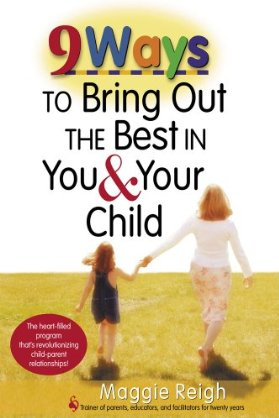 Author: Maggie Reigh Author: Maggie Reigh
Original Publication: 2004
Started: 2010 Nov 8
Finished : 2010 Nov 23
Format: Paperback
239 pages / 16 days
14.9 pages / day
This book was a gift. The inscription on the inside of the cover says:
“With love to Sam – Hope something here is helpful :-) – Mother – 2007”
So this was from my mom, but at a time well before Alex, so we were talking at the time about parenting a 11 or 12 year old Amy , depending on if this was a Birthday gift or a Christmas gift. But see, I do eventually get to reading books I am given as a gift… even though it may take a few years.
I am generally very suspicious of these sorts of books that tell you how to be a better whatever, be it a better parent or a better manager, or just a better person. It isn’t that they can’t hold nuggets of truth, but rather that many of these things either just come naturally or they don’t, and I am dubious of learning such things from instruction rather than from experience. Having said that, there is always the bonus of actually learning from other people’s experience rather than repeating their mistakes, and I must admit I did end up noting a few things in here where I thought “Yeah, I could do better at that.”
Now, most of the advice, the “9 Ways” are things that might get a “Well duh” reaction from anyone who did not come from a background where the old fashioned disciplinarian “kids will speak when spoken to and do what they are told” sort of style was the norm. At least in the circles I have traveled that sort of thing has been quite rate. To some degree this book comes down to “don’t do that” and instead treat your kids with respect and as people.
To be specific, the 9 “Ways” are:
- The Way of Mutual Respect (Understanding and Respecting Boundaries)
- The Way of Vision (Have an idea of how you would like things to be and evaluate things on if they help get closer to that.)
- The Way of Mutual Empowerment (Turn judgement to curiosity, empower your child to decide things on their own as soon as they are ready and want to.)
- The Way of Emotional Grounding (Staying centered and enabling the draining of frustrations… both yours and the child)
- The Way of Communications (Talk and communicate meaningfully. Listen.)
- The Way of Encouragement (Encourage, be specific, look for the good in things rather than obsessing on flaws)
- The Way of Living Harmoniously with Others (Don’t resolve kid’s arguments, teach them how to resolve them)
- The Way of Loving Discipline (Not punishment, self-control. Help find root causes of misbehavior to find solution.)
- The Way of Parenting with Spirit (Some sort of nonsense about inner lights)
Anyway, as you can see from those titles, there is a lot of fru-fru gobbledegook pop-psychology in here in terms of the terms used to describe various things. And some of the anecdotes also seem like the idealized “yeah, no real person would react quite like that” sort of thing. But they do serve to illustrate the basic principles though. I’ve tried to distill the actual meaningful essence in my parenthetical comments. And I do think once you boil out all the fluff here, the general principles are good ones.
As I mentioned earlier, there were definitely a variety of places where when reading I thought of various interactions I’ve had with Amy (not so much Alex yet) where I could have taken a better path if I’d followed some of the advice in here. In most cases, actually obvious in retrospect, but where in the moment as things happen, perhaps thoughts aren’t as clear. The value of a book like this, as I said, unless you are coming from a strict child-rearing starting place, which I am not, is not so much telling you anything you don’t already know… you know this stuff instinctually… rather it is that it makes you take the time to think about it a bit and raise it to something you are consciously aware of , and therefore perhaps you will be better able to step back and approach things in more healthy ways in situations where perhaps before you might just react and then think “oops, I could have handled that better” after the fact.
Or not. Even when you know a better way, sometimes the moment wins. But it is good to just explicitly think about some of this stuff sometimes.
Wow, oops. I can’t believe I’ve been mostly positive about this book. I *am* skeptical about this kind of book. And a good portion of this book WAS fluff and such, and the last chapter really did start taking a sharp right turn into LaLa Land, but if you pick through all that stuff, the core bits are indeed valuable to spend some time thinking about.
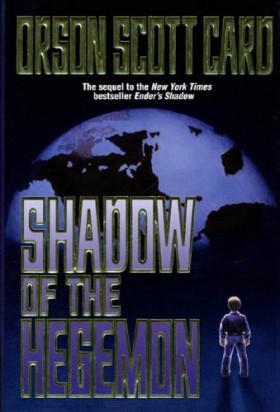 Author: Orson Scott Card Author: Orson Scott Card
Original Publication: 2001
Started: 2010 Oct 30
Finished : 2010 Nov 8
Format: Kindle
7231 locations / 10 days
723 locations / day
So here I go, I am now up to Book 6 in the Ender Series. This book once again concentrates on the character of Bean, the minor character in Ender’s Game that got a deeper background in the last book, Ender’s Shadow. Now that the Buggers / Formics have been defeated, the action shifts back to Earth, where the unity of the planet during the war against an alien threat has fallen apart, and now major geopolitical shifts are under way as national powers start reasserting themselves.
In this context, the former members of Ender’s team (including Bean) become major players, as they are considered the brightest military minds on the planet. An old rival of Bean’s from his childhood who was introduced in the last book also plays a huge part as the villain, constantly plotting for his own power, but more importantly for revenge against all those, such as Bean, who had ever seen him in positions of weakness.
There is some interesting geopolitical speculation here, looking at how a world might look several hundred years in our future, after an interlude where the planet had been forced to unite, but no longer is. But even given the premise of this cadre of super-bright children who had already saved the world, it does start to stretch the suspension of disbelief a little bit when you essentially get a handful of teenagers engaging in machinations that direct the course of major nations as they go into and out of war. It is an entertaining story, and once again Card is doing a novel that concentrates on events and actions as opposed to philosophical speculation. They are different sorts of novels. Both good in their own way.
This is maybe in the middle of the pack of the series so far in terms of how much I’ve enjoyed it. Not as good as #1, #2 or #5 in this series, but probably better than #3 and #4. Dunno. They are all enough different from each other that it is hard to compare.
Worth a read if you like this series. I wouldn’t suggest picking it up without having read at least #5 though, since it follows directly on from that book.
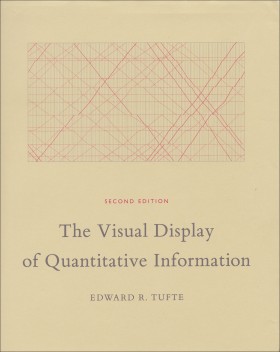 Author: Edward R. Tufte Author: Edward R. Tufte
Original Publication: 2001
Started: 2010 Oct 24
Finished : 2010 Oct 30
Format: Hardcover
197 pages / 7 days
28.1 pages / day
So, back to a physical book again. This one was part of the spoils from going to Tufte’s Lecture back in June. All the attendees got his four major books, of which this, The Visual Display of Quantitative Information is the first. Since I went to the lecture for work, this is on my work non-fiction list.
Of course, I’d seen this book around and heard about it for many many years. I remember talking to colleagues about this book way back when I first started doing web and internet related stuff in the 90’s. That would have been the first edition of course. What I read now is the second edition, but I gather the changes were more in terms of corrections and improvements to images and such, rather than fundamental changes to the content.
Tufte’s books been, and especially this one, have been held up essentially as bibles for good visual information design. Having now seen his lecture and read the first of his books, my initial impression is that while he certainly makes a number of good points, especially when it comes to things that are routinely done badly and which should be avoided, he falls down a bit in terms of his positive suggestions for new sorts of presentations. It seems that perhaps he is a little overhyped. Of course, there is also the possibility that it only seems that way because many of his recommendations have become so widely regarded over the years that when you hear them now you think “Well, duh! How could anyone think otherwise?” whereas when he first articulated his ideas they were a brand new perspective. I think this is quite likely.
Of course, his major complaint is with information graphics that are full of what he calls “chart junk” or misrepresentations. Basically decorative elements that add no information and often detract from understanding the data, or choices of graphical treatment that leave a casual viewer with an incorrect impression of the data. He gives many examples of these sorts of bad usages. The core message is to strip away the extraneous elements and concentrate on the data itself, and then be extremely careful to show that data in a way that highlights the important aspects of the data honestly. This is excellent core advice.
He does get a little too sparse in some cases though, or recommends presentations that he himself says may stray into “puzzle” territory, where the person looking at the chart has to figure out what some of the new conventions mean. I suppose some of this just has to do with being used to the standard conventions. But in some cases I think it is just a case of taking good general principles a bit too far. For instance, remove the frame and gridlines around many plots. Now, certainly gridlines should be light enough to not interfere with looking at the data, but I like having them damn it, and the frame separates out the data from whatever is surrounding it. Yes, I get they may not be completely necessary, but I actually think they help in many cases.
Oh, and of course Tufte introduced sparklines. These can be useful in certain contexts, but I generally don’t like them.
There. I got my curmudgeonly bit out.
In any case, this is a classic on these topics, and well worth reading. Even if you don’t buy into every last bit of what Tufte is saying, the general principles are right on the money and worth considering whenever you are trying to present any quantitative data graphically.
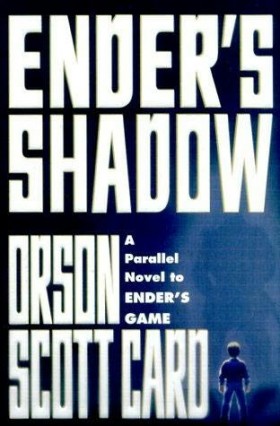 Author: Orson Scott Card Author: Orson Scott Card
Original Publication: 1999
Started: 2010 Oct 16
Finished : 2010 Oct 24
Format: Kindle
8807 locations / 9 days
979 locations / day
So here we are, continuing the Ender Series. I had thought that I had read Books 1 to 4, but had never read any of the Shadow books that start with Book 5, Ender’s Shadow. Within seconds of starting the book however, I realized that I was wrong. I had indeed read Ender’s Shadow before. While I couldn’t really remember forward, and know for sure what was going to happen on the next page or the next chapter, I did get a strong sense of familiarity with every page I read, like ongoing deja vu. Which of course is in perfect alignment with me having read this before, but many years ago. Most likely not long after it came out in 1999.
In any case, this is essentially a retelling of the same story told in Ender’s Game, but told from the perspective of one of the minor characters in the original book, namely “Bean”. In some ways Bean ends up being a more interesting character than Ender himself, if only by the mere fact that he wasn’t seemingly always the best at everything (although still at many things) and therefore had do understand and deal with his secondary role. At the same time, he was more aware of the larger context of what was going on than Ender, who was pretty oblivious to some major things, of course including the major reveal at the end of the first book. Bean on the other hand, figured out what was really going on and undertook his actions fully knowing the consequences, which in some ways made those events even more poignant.
In more general terms, as Card returns to revisit the events of the first Ender book, he also returns more to the form of a more event driven story, rather than the exploration of philosophical ideas that characterized books 2-4. And while I do enjoy those sorts of explorations, it was nice to return to a more “direct” sort of story for a bit. And it is also fun to see the same events from two radically different perspectives. This is of course a narrative trick that has been used in many different contexts before, from “Rosencrantz and Guildenstern Are Dead” to “Lower Decks” and many others, but it is still fun on occasion.
Bottom line, a good addition to the series which leaves you anticipating the next one…
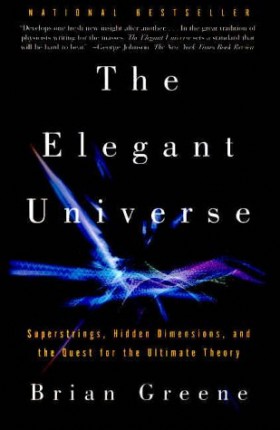 Author: Brian Greene Author: Brian Greene
Original Publication: 1999 Feb
Started: 2010 Oct 9
Finished : 2010 Oct 16
Format: Kindle
7369 locations / 8 days
921 locations / day
So, here we go. This was my first Kindle book. Woo! It was also the first picked by my new method. Double Woo!
First of all, I’ll get the Kindle stuff out of the way. I love reading on the Kindle. I love the convenience. I love being able to switch back and forth between the Kindle device and my iPhone at will, and I do so regularly. All in all it is a great experience for this kind of reading. I want all my reading to be this kind of reading in the future.
So now, rate… there are no pages, just “locations”, so there is no direct comparison to the “pages per day” I used to mention. Now, I could find out how many pages the paper book had and do the math to convert, but locations is the measure here, so that is what I will use above. In reality though, what this means is that looking at location rates and page rates trying to compare them between Kindle books and Paper books just isn’t that meaningful, so in general I’m switching to just looking at my book rate. In this case, one book in 8 days. Of course, this is also dependant on the length and type of the books, but whatever.
Oh, the book itself… this is of course a popularly focused book on String Theory. Although I was a physics major, I never got to study string theory in college. I did some Cosmology. I did some Quantum. I can’t remember if I did GR. In any case, this was going to cover an area where I’d read a bit in popular accounts before that included some string theory stuff, but never anything focused specifically on it. At least not that I can remember.
So, almost exactly the first 30% of the book was review of Special and General Relativity and the Standard Model of Particle Physics. This is all well and good, but this part I was very familiar with. So it was a bit of a slog. It seemed like the same examples and thought experiments and analogies and descriptions of experiments that I’d heard about and read about and in some cases studied academically since at least my teenage years. Can someone some time come up with a new way of explaining special and general relativity that doesn’t follow the exact same path everybody else has followed since Albert came up with them? That would be nice. Of course, for someone who was NOT already familiar with these bits, this part of the book would no doubt be most welcome.
After that first 30% though, we started getting into less familiar territory for me. I still ended up with the same frustration I often feel with popular physics books though… too many analogies and not enough of the actual math. Now, don’t get me wrong. I don’t want an actual full fledged graduate school textbook or anything. At times I’ve picked up such textbooks on General Relativity or the like, and I know that’s not I want right now either. I want something in between. Something that does not require a graduate degree in Physics or Math to understand, but yet is not afraid to assume the reader has a basic understanding of, say, Calculus level math, with perhaps a touch of number theory or some such. Of course, the audience for such a book would probably be pretty limited, which is why you either see the general interest book with almost no mathematics, or you see actual textbooks, with years of prerequisites study needed to really “get” it, and most likely even then, it would be the kind of thing that would massively benefit from in person classes to go along with it. So I guess I’ll not get that kind of thing any time soon.
So anyway, non-methematical as it was, the last two thirds of the book did get into aspects of String Theory that if I ever knew, I didn’t really remember beyond the very high level notion of there being multi-dimentional vibrating strings. And there is some exciting stuff there. The biggest sense one was left with though was of a field that was a work in progress. One where a lot of potential was visible, but not yet realized. A lot more questions than answers. The tone was one of eager optimism that over the next few years a lot more would become clear. Of course, this was published in 1999. More than a decade has gone by. My general impression from passing references on blogs and the like (rather than any in depth study of course) is that we may still be in the same sort of spot today. Where we still have a situation where String Theory isn’t yet in a position to make concrete predictions that can actually be tested with current (or near future) technology, and where there are still lots of variations on the core theory, without a good way of choosing between them. Like I said though, I could be wrong, and welcome clarification from someone who knows better.
Or maybe recommendations for a more recent book on the subject that will fill in the last 11 years of progress in the field.
One thing I’d particularly like to read more about is the Holographic Principle. That sounds like great fun. So does Entropic Gravity. If anybody has some book recommendations that cover those topics, send them my way! :-)
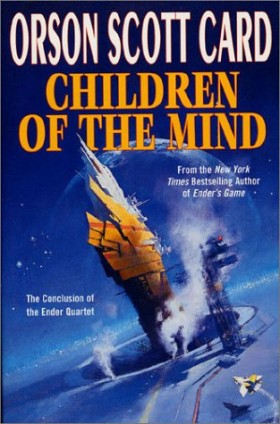 Author: Orson Scott Card Author: Orson Scott Card
Started: 3 Oct 2010
Finished: 9 Oct 2010
Format: Paperback
349 p / 7 d
49.9 p/d
OK, now that is more like it. Almost 50 pages per day and a book finished in a week. Compared to the text book before this, that is just lightning speed… Of course, I’m usually much faster with fiction and this was an easy read.
This is of course the next book (#4) in the Ender Series. I’m working my way through the series to get to #11, which Brandy gave me for Christmas or a birthday or something a couple of years back. :-) I had finished the last one back in April.
This one continues directly from the previous book with no gap in time whatsoever. It follows a couple of “characters” who are essentially just artificial extensions of Ender himself as they (and others, including the original Ender) try to prevent the destruction of a planet and a sentient computer network.
Continuing the trend of the last couple of books in this series, what goes on is decreasingly about events and actions or even characters, but instead is Card exploring a particular concept of the nature of the soul and what it means in relation to the various characters in the story, the species they belong to and toward the whole of the universe I guess. This is all an interesting thought experiment. He proposes a physical extra dimensional sort of thing that embodies the soul or the will or whatnot, and which essentially possesses physical objects, with the “stronger” of these things being able to take control of complex entities such as human beings and with the ability to “intertwine” with other of these things as embodiment of relationships between people, etc. He then pursues some of the ramifications of that sort of structure. As I said, interesting thought experiment.
Overall a good book, if you are into the kind of book that is really more about exploring ideas and concepts that being a page turner based on plot alone.
Oh, and of course, the most interesting character here continues to be Jane, the sentient computer network. But then again, I’ve always had a thing for sentient computer networks.
|
|
 Author: Po Bronson and Ashley Merryman
Author: Po Bronson and Ashley Merryman







